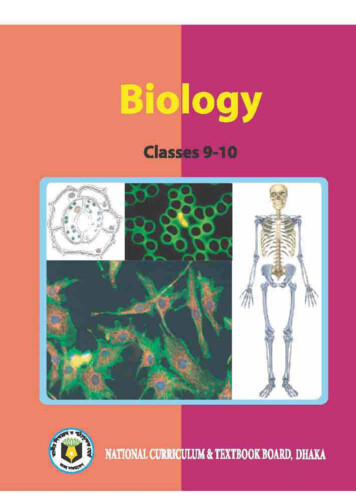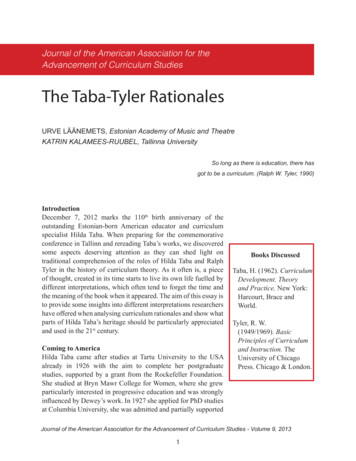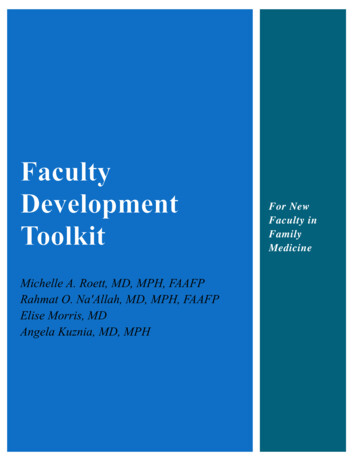
Transcription
Prescribed by National Curriculum and Textbook Boardas a Textbook for class Nine-Ten from the academic year 2013BiologyClass : Nine - TenWritten byS. M. HaiderDr. M. Niamul NaserGul Anar AhmedMd. Idris HowladerEdited byDr. Syed Mohammad Humayun KabirDr. M. Imdadul HoqueTranslated byRajat Kanti ShomeGul Anar AhmedQji Neamul HaqueNational Curriculum and Textbook Board, Dhaka
Published byNational Curriculum and Textbook Board69-70, Motijheel Commercial Area, Dhaka[All rights reserved by the Publisher]Trial EditionFirst Publication : December 2012Co-ordinated byFatema Nasima AkhterComputer ComposeLaser Scan Ltd.CoverSudarshan BacharSujaul AbedeenIllustratorCollectedDesignNational Curriculum and Textbook BoardFor Free Distribution from academic year 2012 by the Government of BangladeshPrinted by :
PREFACEEducation is the pre-requisite for the holistic development in our national life. To cope with thechallenges of the fast changing world and to lead Bangladesh to the doorstep of development andprosperity, a well educated and skilled population is needed. In order to build up a nation imbuedwith the spirit of the Language Movement and our Liberation War, the secondary education aims atflourishing the talents and prospects inherent in the learners. Besides, the other aims also includeexpansion and consolidation of the basic knowledge and skills of the learners acquired at theprimary level in order to make them fit for entry into higher education. The aims of secondaryeducation further emphasise on developing these learners as skilled and competent citizens of thecountry through the process of acquiring knowledge at the backdrop of socio-economic, culturaland environmental settings.Keeping the aims and objectives of National Education Policy 2010 ahead, the curriculum at thesecondary level has been revised. In the revised curriculum the national aims, objectives andcontemporary needs have been reflected. Along with these expected learning outcomes have beendetermined based on the learners’ age, merit and level of acquisition. Besides, efforts have beenmade to raise, starting from the level of moral and humanistic values down to awareness on historyand tradition, the spirit of the Liberation War, passion for art-culture and literature, patriotism,feelings for nature and equal dignity to all irrespective of religions, caste, creed and sex. Effortshave also been made to apply science in all spheres of our life in order to build a nation advancedin science. Attempts are also there to make the learners’ capable of implementing the goalsenvisioned in Digital Bangladesh-2021.In the light of the present curriculum almost all the textbooks at the secondary level have beenintroduced. While introducing the textbooks, the capacity, aptitude and prior knowledge of thelearners’ have been taken into utmost consideration . While selecting the contexts and theirpresentation special attention has been given on the expansion of the learner’s creative faculty.Adding learning outcomes, at the beginning of each chapter, hints about the achievable knowledgeof the learners have been given. By adding variety of activities, creative and other questionsevaluation has also been made creative.The twenty first century is important for the development of Biology. The main purpose of learningBiology is to acquire theoritical and practical education from life. To know nature and life in thesequence of learning is also essential. This scope for knowing the living world with enjoyment hasbeen created in the new Biology curriculum of classes Nine-Ten. Applied aspect along withscientific concept and theory has also been emphasised here in the field of learning Biology. Thiswill reduce learners’ tendency for rote-learning to a great extent and they will be able to internaliseand apply the achieved knowledge in addition to analysing and evaluating things.Considering the challenges and commitments of 21st century and following the revised curriculumthe textbook has been written as a trial edition. Therefor e we welcome with our highestconsideration any suggestions, both constructive and rationale as well for the further improvementof the book. Amidst huge activities needed for introducing a textbook, this one has been writtenwithin a very short span of time frame. We will continue our effort to make the next edition of thisbook more beautiful, decent and free from any types of errors.We appreciate the endeavours of those who assisted very sincerely with their merit and hard workin the process of writing, translating, editing, illustratrating, introducing sample questions andprinting of the book. We hope this book will ensure joyful reading and achievement of expectedskills from the learners.Prof. Md. Mostafa KamaluddinChairmanNational Curriculum and Textbook Board, Dhaka.
CONTENTSChapterPage NoOneLesson on Life1TwoCell and Tissue of Organism11ThreeCell Division32FourBioenergetics40FiveFood, Nutrition and Digestion54SixTransport in Organisms82SevenExchange of Gases104EightHuman Excretion117NineFirmness and Locomotion124TenCo-ordination Process in Animal134ElevenReproduction152TwelveHeredity in Organisms and Evolution167ThirteenEnvironment around Life178FourteenBiotechnology193
Biology1Chapter OneLesson on LifeBiology, an immensely important area of science, plays a variety of crucial roles inensuring protection and welfare of all living beings on earth. With the progress ofscientific development, humans are enjoying a much more comfortable life ,but side byside many more problems are viciously emerging and causing a serious threat to allforms of life and their environment. In that case, biology can help human to face somecritical challenges of the century, and some of these are the production of food,development of medical science and conservation of organisms in their hostileenvironment. In this chapter, the definition of biology, names of its branches and namingsystem of organisms have been discussed.At the end of the chapter, we will be able tox Explain the general concept of biology.x Describe the main branches of biology.x Explain the classification of organisms.x Evaluate the necessities of the classification of organisms.x Describe the systems of classification of organisms.x Explain the concept of Binomial Nomenclature of organisms and its significance.x Become conscious of the necessity of classification of organisms in practical life.
2BiologyConcept of BiologyIn nature, we generally find two types of objects, nonliving things and living organisms.The characteristics of nonliving things are usually discussed in Physics and Chemistry.Biology is a branch of scientific knowledge concerning life and characteristics oforganisms. It is one of the oldest branches of natural science. Its background was evencreated before the origin of life on the earth, and you will learn more about it at yourhigher classes.By studying biology, one can acquire interesting knowledge of different plants andanimals and human life. In the realm of living creation, the presence of life in a livingcell is remarkable. This is why a good command of biology plays an important role inknowing more about the different parts and organ structure of organisms, differentchemical activities in them, their adaptation with their environment, their intake ofnutrition and reproduction. The roles of a cell or cells in all steps of life are indisputable.Science has a great contribution in our everyday activities and developing ourexperience. For our living survival, the fundamental base of biology is inherent in thecomponents of our environment. At the time of walking, our muscles conduct our legs,our nerves move our muscles and the blood circulation in our muscles provides themwith oxygen, nutrition and strength. A single celled organism also survives in the sameway using oxygen, nutrition and energy. For the maintenance of biological existence, allliving organisms require oxygen and energy. An animal derives this energy from foodproduced by plants themselves and other sources.Biology is one of the fundamental branches of science. The term biology is derived fromthe Greek word , bios, "life" and the suffix - , -logia, "study of." Greekphilosopher Aristotle (384BC – 322BC) is called the father of biology. Biology is thebranch of science concerned with the study of life and living organisms, including theirstructure, function, growth, reproduction, classification, origin and evolution.Branches of BiologyBased on the type of organism, biology is divided into two branches – Botany andZoology. Grounded on the aspect of consideration, there are also two other divisions ofbiology - physical biology and applied biology.Physical BiologyIn the field of physical biology, theoretical concepts are usually discussed. Thefollowing subjects are the general fields of its concern.1. Morphology: The field deals with the form and structure of organisms. It is usuallydivided into two branches – external and internal morphology. The externaldescription of the body is called external morphology and the internal description ofthe body is called internal morphology.2. Taxonomy: Classification of organisms and the principles related to this task arediscussed in the field.
Biology33. Physiology: This branch of biology deals with the biochemical activities of differentorgans of organisms. Besides, detailed description of all the physiological process oforganisms is found in it.4. Histology: The microscopic structure, arrangement and function of plant and animaltissues are studied in this subject.5. Embryology: The branch of biology discusses the development of embryo oforganisms.6. Cytology: The structure, function and division of an individual cell in a body oforganisms are studied in this field of biology.7. Genetics: The branch of biology deals with genes and heredity.8. Evolution: The gradual development of life and organisms over successivegenerations on earth is studied in this subject.9. Ecology: It is the science of reciprocal relationship between organisms and theirenvironment.10. Endocrinology: The field of science deals with the study of endocrine glands andhormones secreted by them in a body of organisms.11. Biogeography: The branch of biology studies the geographical distribution oforganisms, past and present, throughout the landscape of planet earth including theknowledge of classifying bio-geographical patterns.Applied Biology :Applied subjects related to life are included in this category, and some of them arementioned below:1. Palaeontology: Science of the prehistoric life forms and fossils;2. Biostatistics: Science of statistics of organisms;3. Parasitology: Science related to parasitism, life process of parasitic organisms anddiseases caused by them;4. Fisheries: Science dealing with fish, harvesting of fish, management andconservation of fish assets;5. Entomology: Science related to the study of life, merit, demerit, and control ofinsects including the losses caused by them;6. Microbiology: Science related to virus, bacteria, fungi and other microorganisms;7. Agriculture: Science concerning agriculture;8. Medical Science: Science related to human life, disease, treatment etc.;9. Genetic Engineering: Science associated with gene technology and its utilities;10. Biochemistry: Science connected to biochemical process and diseases of organisms;11. Soil science: Science related to soil, soil structure and soil environment;12. Environmental Science: Science related to environment;
4Biology13. Oceanography: Science related to ocean and its resources;14. Forestry: Science related to forest, management and conservation of its resources;15. Biotechnology: Science associated with the technology of utilising of organisms forthe benefit of mankind;16. Pharmacy: Science dealing with technology and industry of medicine;17. Wildlife: Science related to wild animals;18. Bioinformatics: Biological information based on computer technology, informationon the analysis of cancer, for example.Work: Looking at the pictures below, present each of them in a list under the biologicalbranch they belong to.Classification:About four million of different plant species and thirteen million of animal species havebeen named and described till today. The number is not yet final because the descriptionof more and more new species is being added to it almost every day. It is assumed thatthe number will reach a crore in future when the description of all the organisms will beended. A large number of organisms are needed to be grouped systematically for theconvenience to know, understand and learn them. Many years back natural scientists feltthe necessity to classify living world following a natural system. From this verynecessity, a distinct branch of biology, taxonomy had emerged. The aim of classificationis only one to know the vast and diverse living world accurately and classify them withlittle effort in a short period of time.The contribution of Swedish botanist, physician and zoologist Carolus Linnaeus (17071778) in the field of taxonomy is more worth mentioning. In 1735 at the age of 28, hetook his doctoral degree in medicine at the University of Harderwijk, and in 1741 he wasappointed Professor of Medicine at Uppsala University. Though he was first responsible
Biology5for medicine-related matters, soon he changed his position with the other Professor ofMedicine to become responsible for the Botanical Garden, botany and natural historyinstead. He thoroughly reconstructed and expanded the Botanical Garden. It was themain field of his intense interest to classify organisms from his botanical and zoologicalobservations that he assembled from his many expeditions. He classified living worldinto two kingdoms – Plant and Animal.In 1953 Linnaeus published his book Species Plantarum which is internationallyaccepted as the starting point of modern botanical nomenclature and in 1958 he releasedthe tenth edition of his book Systema Naturae which established itself as the startingpoint for zoological nomenclature. He first defined the term genus and species in hisbook. Based on the observations of size, structure and characteristic, plants and animalsare named. On the basis of each other’s similarity and dissimilarity, grouping organismsis called classification.Aim of ClassificationThe aim of classification is to acquire knowledge of every group and subgroup of eachorganism. To document the accumulated information systematically focusing on thediversity of living organisms, introduce the total knowledge concisely and take propersteps after identifying organisms to conserve them or increase the number of species forthe well-being of human beings and the living world are the objectives of classification.Living WorldUntil recently, from the age of Carolus Linnaeus up to the middle of the twentiethcentury, all living organisms were classified in one of two kingdoms: Animals andPlants. With the progress of science, on the basis of data collected from time to time, forinstance, the type of DNA or RNA in a cell, features and number of cell in a living bodyand mode of nutrition that a cell adopts, a five-kingdom classification was proposed byR.H.Whittaker in 1969. Then Margulis introduced a modified and expanded form ofWhittaker’s classification in 1974. She divided the whole living world into two superkingdoms and grouped the five kingdoms under these two super-kingdoms.Superkingdom-1: ProkaryotaThey are microscopic, prokaryotic and onecelled organisms.Kingdom-1: amentous,colonialorabmycelial. Though chromatin material ispresent in every cell, there is no nuclear Figure: 1.1 a) Bacteria b) Nostoc (Blue green algae)membrane and nucleolus in their cells. Noplastids, mitochondria, endoplasmic reticuli are there in their cells but ribosome ispresent in them. Cell divides through the process of binary fission. Their chief mode of
6Biologynutrition is absorption though some of them produce their food through the process ofphotosynthesis or chemosynthesis.Example: Bacteria, Blue green algae;Superkingdom-2: EukaryotaThey are eukaryotic and unicellular or multicellularand live induvidually or in a colonial form.Kingdom-2 : ProtistaCharacteristics: They are unicellularmulticellular, individual or colonial ororfilamentous and the nuclei in their cells are wellstructured. Their cells contain nuclear materialsFigure: 1.2 a) Amoeba b) Diatombounded by a nuclear membrane. In chromatinmaterial, there are DNA, RNA and protein. Alltypes of cell organelles are there in their cells. Their modes of nutrition are absorption,ingestion or photosynthesis. They accomplish their asexual and sexual reproduction bythe process of mitosis and conjugationrespectively. No embryo is developed in them.Example: Protozoa (Amoeba, Paramecium) andunicellular algae, diatom for example;Kingdom-3 : FungiCharacteristics: Most of them are terrestrial,saprophytic or parasitic. Their body is constitutedwith a single cell or mycelium. Nucleus is well Figure: 1.3 a) Penicillium b) Mashroomorganised. Cell wall is composed of chitin. Theirmode of nutrition is absorption. The photosynthetic apparatus chloroplast is absent inthem. They reproduce by haploid spores. Their cells divide through mitotic cell division.Example: Yeast, Penicillium, Mushroom etc.Kingdom-4: PlantaeCharacteristics: They are photosyntheticand prokaryotic. Advanced tissuesystems are found in them. They developembryo and diploid stage is started from it.They are mostly terrestrial but there arealso many aquatic species underthis kingdom. Their sexual reproduction isof anisogamous type. They arearchegoniates and flowering plants.Figure: 1.4 a) Spirogyra Multicellular algaeb) Jackfruit tree
Biology7Example: Advanced green plants, multicellular algae;Kingdom-5: AnimaliaCharacteristics: They are eukaryotic and multicellular animals. Their cells possesnon-living cell wall, plastid and vacuole in them.Because of having no plastid in their cells, they areheterotrophs, and so they depend on other organismsfor their food. After ingestion, they digest their food.They have advanced and complex type of tissuesystems. Sexual reproduction is their usual way ofreproduction. Haploid gametes are usually producedin the reproductive organs of mature and diploid maleand female. Embryonic layers are developed at thetime of their embryonic development.Figure: 1.5 Royal Bengal TigerExample: The entire invertebrate (except protozoa)and vertebrate animals.Thomas Cavlier-Smith from Oxford University divided the kingdom Protista of livingworld into two groups, and renamed the kingdom Monera as the Kingdom of Bacteria in2004. In this way, he grouped the living world into six kingdoms. You will learn moreabout it at your higher level of education.Taxonomic rankIn classifying the organisms, some units or ranks are used in taxonomy. The largestclassification rank is kingdom, and the smallest classification rank is species.KingdomPhylum / DivisionClassOrderFamilyGenusSpeciesIn modern classifications, the ranks are divided into sub-groups as the necessity demands.System of Binomial NomenclatureThe scientific name of an organism is constituted with two parts. The first part of the namedenotes the genus to which the species belongs; the second part identifies the species withinthe genus. The scientific name of potato is Solanum tuberosome, for example. The wordsolanum and tuberosome denote the genus and species name of potato respectively. Thesystem of scientific naming of an organism with two parts is termed as binomial nomenclature.The binomial nomenclature serves only one aim, and that is to know every organism by itsunambiguous name. The scientific naming of an organism is accomplished in accordance withsome rules and regulations set internationally. The scientific name of a plant and an animalshould be accorded with the declared principles of International Code of BotanicalNomenclature (ICBN) and International Code of Zoological Nomenclature (ICZN)
8Biologyrespectively. In fact, the codes are documented in a printed form. As the scientific naming ofan organism is expressed in the language Latin, a legitimate name is unambiguously acceptedthroughout the whole world.The great Swedish naturalist Carolus Linnaeus laid the foundations for the modernsimpler system of naming organisms and effectively began the task with his bookSpecies Plantarum in 1753; the original description of naming organism is found in thetenth edition of his work Systema naturae in 1757. He defined the term species andgenus, and used the ranks of classification class, order, genus and species in his work.The introduction of the formal system of naming organism by Carolus Linnaeus isundoubtedly a striking step in the history of biology. Some of the notable principles ofbinomial nomenclature are mentioned below:1. The language of scientific naming of an organism would be Latin.2. Every scientific name should have two parts, and the genus name always comes firstfollowed by the species name.3. The scientific name of any organism should have to be unique because a samelegitimate name cannot be used for naming two distinct organisms.4. The first alphabet of the first name would be in capital letter with the remainingalphabets in small type, and the second part of the name totally would be with smallletters. For example, Onion- Allium cepa, Lion – Panthera lea.5. At the time of printing of a scientific name, it should be done with Italic type. RiceOryza sativa, Katla fish- Catla catla, for example.6. When a scientific name would be written in hand, two parts of it should beseparately underlined. For example, Oryza sativa, Catla catla.7. If the scientific name of an organism is named by some scientists, the earliestlegitimate name given by the first scientist will be accepted in accordance with therules of priority.8. The name of the author who would scientifically name an organism can be cited inabbreviated form at the end of the binomial name with mentioning of the year of naming.Binomial names of some organisms:General nameScientific nameRiceOryza sativaJuteCorchorus capsularisMangoMangifera indicaJackfruitArtocarpus heterophyllusWater lilyNymphaea nouchaliJabaHibiscus rosa-sinensisCausal organisms of choleraVibrio choleraeCausal organisms of malariaPlasmodium vivaxCockroachPeriplaneta americanaHoney beeApis ceranaIlishTenualosa ilisha
BiologyAsian toadOriental Magpie-RobinTigerHuman9Bufo melanostictusCopsychus saularisPanthera tigrisHomo sapiensExerciseShort answer questions:1. What is the significance of learning biology?2. Write down the name of physical branches of biology?3. Write down the name of applied branches of biology?4. What is binomial nomenclature?5. Mention the ranks of classification.Essay type questions:1. What are the necessities of classifying organisms?Multiple choice questions:1. In which branch of biology are insects discussed?a. Entomologyb. Ecologyc. Endocrinologyd. Microbiology2. The aim of classification isPilusi. to know about the sub-ranks of organismCellmembraneCellwallii. to be able to name the units of organismDNAiii. to present the knowledge in detailCytoplasmMesosomeWhich one of the following is correct?a. i & iiib. i & iiFlagellumc. ii & iiid. i, ii & iiilook at the stem and answer the question 3 & 4.3. What is the name of the organism shown in the picture above?a. Amoebab. Diatomc. Parameciumd. acterium4. The characteristics of the organism shown in the picture of the stem are.i. able to moveii. unable to produce foodiii. nucleus is well-structured
10BiologyWhich one of the following is correct?a. i & iib. ii & iiic. i & iiid. i, ii & iiiCreative question1.a.b.c.d.What are the units of classification?Why is genetics called the physical branch of biology?How will you maintain the continuity in naming the plant in figure 2?Analyse with explanation which organism is more advanced between the two shownin figure 1 and figure 2.
Biology11Chapter TwoCell and Tissue of OrganismYou have already acquired the concept of a biological cell at your previous classes .Now, based on the previous idea, you will be able to learn more about it. Do the views ofa cell of an organism appear the same under both a light microscope and an electronmicroscope?In this chapter, the cells and tissues observed under an electron microscope will bediscussed.At the end of this chapter, we will be able tox Explain the functions of main organelles of plant and animal cells.x Compare a plant cell and an animal cell.x Explain the role of different types of cell in performing properly the function ofnerve, muscle, blood, skin and bone.x Evaluate the appropriateness of cell in the body of a plant.x Explain plant tissues.x Explain animal tissues.x Evaluate the functions of tissue on the basis of grouping the similar type of cells andperforming the same action.x Explain the organisation of cells in tissue, organ and organ system.x Explain the concept and importance of organ and organ system.x Draw the labelled diagrams of plant and animal cell after observing them under amicroscope.x Use a microscope properly.x Understand the contributions of cell in different activities of organisms.You studied at your previous level of education that the cell is the structural unit of anorganism. A building is made up of thousands of bricks; likewise an organism is structuredwith millions of cells. What is a living cell? Some scientists describe a living cell as the unit ofstructure and biological function of an organism. In 1969 Loey and Siekevitz described a cell,
12Biologysurrounded with a selectively permeable membrane, is a unit of living activities, which canexactly duplicate itself without any different living medium.Types of CellOn the basis of the organisation of nucleus, cells can be divided into two types –prokaryotic cell and eukaryotic cell.a) Prokaryotic cell:A prokaryotic cell does not contain any true nucleus. This is why it is called a cell with aprimitive type of nucleus. The term nucleotide fits nice in this case. Nuclear materials ina prokaryotic cell are not surrounded by any nuclear membrane. They are dispersed in itscytoplasm. Though the cell organelles such as mitochondria, plastids, endoplasmicreticule etc. are not found in a prokaryotic cell, ribosomes are present in it. Only theunwrapped DNA constitutes the chromosomal structure of a prokaryotic cell. Forexample, blue green algae and bacteria are constituted of this type of cell.b) Eukaryotic cell:In this type of cell, nucleus is well structured that means nuclear materials are wellorganised and surrounded by a nuclear membrane. Chromosomes are organised withDNA, histone protein and other components. From algae to higher flowering plants andfrom Amoeba to advanced animals, the basic structural and functional component iseukaryotic type of cell. Along with ribosome, other cell organelles are present in the cell.On the basis of function, there are two other types of cells: somatic cell and gametic cell.i) Somatic cell: This type of cell takes part in the organisation of the body of anorganism. The cell divides through the process of binary fission and mitotic division.Organisms grow in this way. Moreover, cells take part in the organisation of differentorgans and organ systems.ii) Gametic cell – Gametal cells are produced in the organisms in which sexualreproduction and alternation of generations occur. Primordial germ cells divide throughmeiotic division and produce gametic cells. In a gametic cell, number of chromosomebecomes half than that of its somatic type. A new living body is commenced after thefusion of male and female gametes. Half life fuses with another half life to produce a fulllife. Zygote is the first cell produced after the union of male and female gametic cells.Zygote undergoes repeated mitotic division to organise a body of an organism.
Biology13Functions of the Main Organelles of Plant and Animal CellsWe will be familiar with some cell organelles, visible under an electron microscope.a) Cell wall: Cell wall is the unique and outstanding feature of a plant cell. It iscomposed of inert materials. Chemical composition of a cell wall is much complex.Cellulose, hemicelluloses, lignin, pectin, suberin are the chemical components of a plantcell wall. But, bacterial cell wall is composedof protein and lipid. The primary cell wall issingle layered. Secondary cell wall graduallydevelops through the compilation of differentchemical substances secreted from protoplasmon the middle lamellum. At the time ofdevelopment of secondary cell wall, somecavities are formed and they are called pits.Cell wall protects a cell from all externalinjuries. It gives a cell its rigidity. Cell wallretains the shape and size of a cell. Forexchanging materials with the adjacent cell, plasmodesmata are formed in a cell wall.Cell wall controls the movement of water and minerals. There is no cell wall around ananimal cell.b) Plasma lemma: The double layered membranearound the protoplasm of a cell is called cellmembrane or plasmalemma. In a plant cell, cellmembrane is attached with the cell wall from theinner side of the cell. The double layered membraneis much flexible. The foldings of a cell membraneare called microvilli. It is mainly composed oflipids and proteins. For its being selectivelypermeable, the membrane can control themovement of water and minerals through the process of osmosis, and separates a cellform its neighbouring cells.c) Cytoplasmic organelles: You have already studied what cytoplasm is at yourprevious classes. The semi-transparent, jel-like, semisolid substance in a cell is calledprotoplasm. All the contents surrounded by the cell membrane is protoplasm. Outsidethe nucleus, the harbouring jel-like substance is called cytoplasm. Many cell organellesare there in cytoplasm. They have different functions. Now,
Mar 09, 2013 · Prescribed by National Curriculum and Textbook Board as a Textbook for class Nine-Ten from the academic year 2013 . have also been made to apply science in all spheres of our life in order to build a nation advanced . way using oxygen, nutrition and energy. For the maintenance of biological










